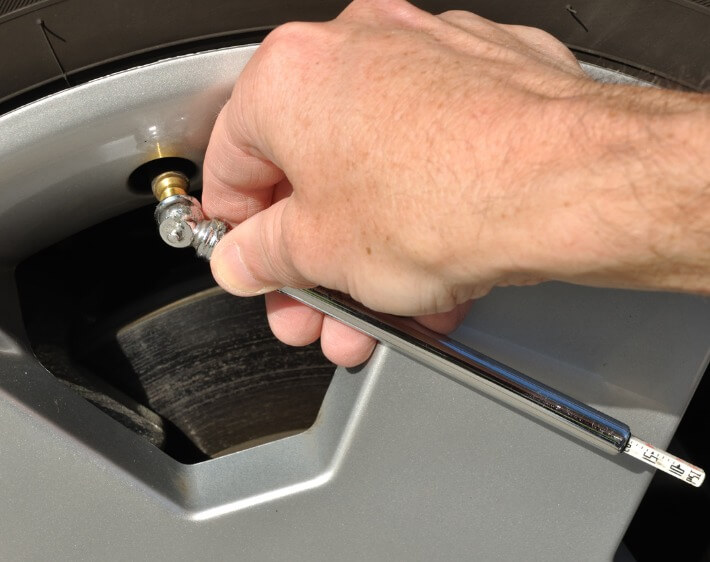 Your tires roll and roll and roll...until they don't anymore. All tires wear out over time, but did you know that you could be unknowingly shortening their lifespan and compromising your safety on the road?
Your tires roll and roll and roll...until they don't anymore. All tires wear out over time, but did you know that you could be unknowingly shortening their lifespan and compromising your safety on the road?
Just like the rest of your car, your tires need some good ol’ TLC every so often! Take a few moments to read up on our top tire care tips and show your tires some love during National Tire Safety Week 2019.
1. Check your tire pressure at least once a month.
Under- or over-inflated tires can compromise tire performance and lead to an issue that causes you to be stranded on the side of the road. To ensure your tires are properly inflated, use a tire pressure gauge to manually check inflation pressure at least once a month and before long road trips.
Stick to the recommended pressure indicated by your vehicle manufacturer, and keep in mind that you'll need to wait a couple of hours after driving to allow your tires to cool (this will get you the most accurate pressure reading).
If temperatures are unpredictable in your area, check your tires more often, as varying temperatures can significantly affect inflation pressure. Tire pressure can increase in warm weather and decrease in cool weather–1-2 pounds for every 10 degrees of temperature change.
Not sure how to check your tire pressure at home? Check out TireSafety for short how-to videos and essential tire care tips as told by lifestyle blogger @LivingWithLandyn.
2. Visually inspect your tires.
It may sound simple, but taking a good look at your tires is an integral part of tire safety and maintenance. Visually inspect your tires every few weeks and note any signs of damage or excessive wear. According to the National Highway Transportation Safety Administration, worn-out tires are three times as likely to be involved in a crash.
Not sure what you’re looking for? Read up on the different parts of tires and learn how to identify common tire wear patterns so you can spot potential problems long before they cause lasting damage. Or, visit your nearest Firestone Complete Auto Care for a quick Courtesy Check. We'll inspect your tires for free.
3. Keep your spare tire in tip-top shape.
Riding around on a flat or near-flat tire can wreak havoc on your car. When you’re visually inspecting your tires, don’t skip the spare! Check that it's properly inflated and look for any signs of damage to ensure your spare is ready for action.
Learn how to change a flat tire so you can keep your car on the road until you can repair or replace your damaged tire.
4. Have your alignment checked every year.
Did you know? Even one pothole can damage your car's alignment and have a negative ripple effect on your tires. Have your wheel alignment checked about once a year, or ASAP if your vehicle has a shaky steering wheel or seems to be pulling to one side.
Wheel alignment has several benefits beyond helping your tires wear evenly—it can also increase fuel efficiency and make for a smoother ride.
5. Check and correct your tire balance.
Tire alignment vs. tire balance: they’re not the same thing! Both are important for tire safety. While tire alignment refers to the angles at which your tires are situated on your car, tire balance refers to the weight distribution of tires around the car.
If you’re experiencing vibration or shaking, especially at speeds higher than 50 MPH, improper tire alignment or balancing could be the issue. For professional yet affordable tire balancing services, visit your nearest Firestone Complete Auto Care. We’ll help keep your ride smooth and your tires in good condition as they wear.
6. Rotate your tires at regular intervals.
Have you noticed? Almost all of these tire safety tips are meant to help your tires wear evenly. Tire rotation is no exception! It can be confusing to remember how often to have your tires rotated, but in general, a good rule of thumb is to rotate your tires every 5,000 to 8,000 miles (or as recommended by your manufacturer).
Regular tire rotations can help prevent irregular or uneven wear on tires—two things that could lead to dangerous accidents or costly repairs.
7. Know when it’s time for new tires.
Even with the best maintenance and care, tires will eventually need to be replaced. Not sure if your tires are nearing the end of their lifespan? It’s easy (and cheap!) to check.
Grab a penny. Insert it between the tread of a tire with Lincoln’s head upside down. If any part of his head is hidden, your tires are good to go for a bit longer. If you can see the top of his head, your tread is worn, and it's likely time to replace your tire(s).
Read the full instructions for this simple penny test, and be sure to check multiple spots on each of your tires to get the best idea of their overall tread depth.
Get Tire Safety Support at Firestone Complete Auto Care
Here at Firestone Complete Auto Care, we're big supporters of National Tire Safety Week! We want to do all that we can to help you learn more about your tires and stay safe on the road. Stop by Firestone Complete Auto Care and follow @LivingWithLandyn for help with any of these tire safety tips.



